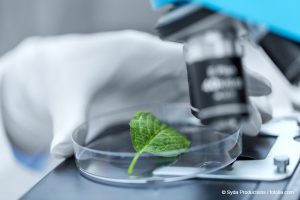Engineered nanomaterials are intentionally and unintentionally released into the environment, which might pose a risk to the ecosystem. Nanoparticulate iron for example is applied as remediation agent and intentionally released in the groundwater in order to remove harmful chemicals. On the other hand, nanomaterials are emitted unintentionally by disposal of nanomaterial-containing products or from wastewater treatment plants. Several factors like concentration, size, morphology and the reactivity of nanomaterials can influence the potential risks for the ecosystem. To estimate potential risks in a reliable way, accurate detection and quantification of nanomaterials in the environment are necessary (see cross-cutting article – Risk assessment of nanomaterials).
Requirements for the analytical methods

Analysis of environmental samples © Syda Productions / fotolia.com
The analytical methods should allow for a detection and quantification of nanomaterials in various environments, for instance fresh water lakes, rivers, soils, and wastewater. They also need to provide information on e.g. composition, size, numbers, concentration and reactivity of the nanoparticles. However, the currently established methods for particle analysis are not directly transferable to nanomaterials for several reasons. For example, some methods only detect pure materials in high concentrations. However, in real environmental samples, mixtures of several different particle types are to be expected that occur in very low concentrations typically in the range of nanograms per litre. This equals to identifying a single “pea”, or even less, in an Olympic-size swimming pool.
Another challenge in detecting nanoparticles in environmental samples is to distinguish between the high amount of different natural particles and the engineered nanoparticles. In many cases, these natural background particles bind to the nanomaterials of interest and mask them thereby complicating the unambiguous and doubtless identification of engineered nanomaterials. Hence, sticking to the swimming pool example, not only “green peas” need to be detected, but also many other quite similar particles such as “chopped herbs”, “olives”, “green beans” (same colour, different shape) or “green apples” (same colour, different size). The analytical technique needs to deliver enough information on the nanomaterial to be able to differentiate between “green peas” and the other particles present in the swimming pool.
Methods like electron microscopy allow for a good identification and distinction of nanoparticles from the accompanying natural particles, a quantification of the particle number in a specific sample volume however is not possible. Other analytical methods provide quantitative information on the sample but have their shortcomings in the differentiation between engineered nanomaterials and natural background particles.
Advancements in analytical methods
At present, for a reliable analysis of nanomaterials in environmental media as well as in environmental organisms, there are no ready-to-use methods available yet, but new concepts and instruments are currently under development.
In addition to the shortcomings already described, the current focus on the determination of inorganic particles (e.g. silver, titanium dioxide) needs to be broadened to organic and carbonaceous particles (e.g. fullerenes) in complex samples such as surface water or wastewater because applications of such materials are growing substantially.
One approach is employing the use of markers that can be considered as unique fingerprints of a certain nanomaterial. These include for example a distinctive composition resulting from impurities in natural particles, elemental ratios or isotopic signatures. For the detection of such types of fingerprints however, additional effort in instrument and method developments is required. Furthermore, sample preparation techniques such as extraction of nanomaterials from solid matrices (e.g. sludge) or the separation of nanomaterials from interfering natural compounds are virtually non-existent and will require much development work.
In summary, a reliable detection of nanomaterials in samples from natural environments requires a high sensitivity and high selectivity. However, it is currently not easy to meet both requirements at the same time as none of the available analytical methods meets all the challenges. Hence, two or more analytical techniques have to be combined in order to collect and report all required information on concentration and type of nanomaterials in an environmental sample. Other important factors for choosing suitable analytical methods are the speed as well as the time and cost expenditures that currently hampers an extensive application of these methods.
Literature
- von der Kammer, F et al. (2012), Environ Toxicol Chem, 31 (1):32-49.
- Laborda, F et al. (2016), Anal Chim Acta, 904: 10-32.
- Hagendorfer, H et al. (2012), Anal Chem 84(6): 2678-2685.
 >
>